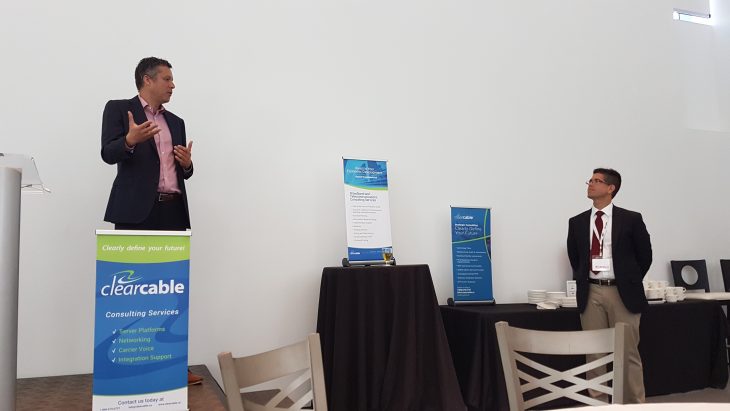
HAMILTON – The Clearcable Summit organizers never shy away from presenting disruptive, sometimes opposing, ideas.
This year it was opener Edo Kweldam of Netherlands independent carrier CAI Harderwijk, whose 40 minute presentation sang the praises of structural separation for network operators. (He is pictured at left with Clearcable president Rob McCann)
His company is one of the few Netherlands cable operations which wasn’t sold to a larger provider. Back in 1995, he said, the country had approximately 300 independent cablecos but now there are just a few large ones, providing all the same services we here in Canada would recognize (TV, phone, Internet).
CAI Harderwijk – which is owned by the regional government – was not sold and instead made a significant strategic shift where it provides no services at all, “just the lines” to whichever provider wants to lease them, explained Kweldam, even KPN, the largest carrier in The Netherlands. This means the network is run very efficiently at 80-90 percent capacity, he said, and they don’t have the worry and expense of competing with many much larger providers and instead sell them all access to a state of the art network.
In keeping with Clearcable’s philosophy to present all ideas, however, the very next speaker was Stephen Eyre, of software vendor Calix, who talked about how carriers should be seen as local innovators because of all the services they can provide and manage for the end consumer as those services are increasingly delivered at the network’s edge. A debate between Eyre and Kweldam might have been neat.
The informative day also saw presentations by Bell Canada counsel Mark Graham who talked up the industry’s FairPlay initiative and how piracy hurts everyone from content creators to network providers – to the tune of hundreds of millions of dollars per year. However, some independent network operators in the audience worried about additional costs when it comes to blocking access to offending foreign websites.
Renowned privacy expert Dr Ann Cavoukian also gave a keynote presentation pushing her idea that all technology – especially in this day and age of smart everything – must feature privacy by design (PBD) where consumers have “personal control of their personal data.” For many early smart devices, and still ones sold now, be it web-connected baby monitors or smart speakers, easy hacks (she had a number of examples) where privacy was violated shows PBD was not considered, leaving people and their data exposed.
Privacy by design, she added, doesn’t have to run contrary to the need for companies to also have data utility. They can and should work hand in hand, should be good for business and must be a consideration whether your company builds a connected gadget – or provides that connectivity.
The Clearcable Summit 2018 attracted more than 150 leaders from the telecommunications sector to the Art Gallery of Hamilton last Thursday June 21st – and the day wrapped up with a dinner and entertainment from Hamilton musician Tom Wilson.
“We started this event as a way to give back to the industry by bringing together all the ideas from the different companies we work with across Canada and from across North America,” said Rob McCann, founder of Clearcable and the summit.
“This year’s agenda digs deep into how we build our networks, but more importantly how we manage and secure them with attention to privacy and piracy,” he added.
“What brings me back to the conference each year is the quality of the speakers and the topics that are relevant to our system and needs,” said Steve Scott , owner of Cross Country TV (Canning, N.S.), a partner of Clearcable, in a release from the company.
Josh Redmore, lead architect, wireless research and development at CableLabs, also spoke on data collection for enabling residential and proactive network maintenance. As well, a panel of McMaster University’s Dr. Suvojit Ghosh, Rogers Communications’ manager of wireline access operations Andrew Laframboise, Clearcable’s Jason Lowe, and Jeff Wilbur of the Internet Society talked about internet of things (IoT) security and privacy – and using artificial intelligence to help with proactive network maintenance.
“This is a great opportunity because I think people are comfortable talking to each other and sharing ideas,” said Jay Thomson, CEO of Canadian Communication Systems Alliance, in the release. “I don’t get a sense there is any reluctance to open up and identify concerns and work towards common solutions if they can possibly do so.”



